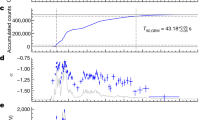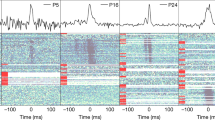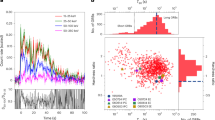Abstract
Knowledge of the properties of γ-ray bursts has increased substantially following recent detections of counterparts at X-ray, optical and radio wavelengths. But the nature of the underlying physical mechanism that powers these sources remains unclear. In this context, an important question is the total energy in the burst, for which an accurate estimate of the distance is required. Possible host galaxies have been identified for the first two optical counterparts discovered, and a lower limit obtained for the redshift of one of them, indicating that the bursts lie at cosmological distances. A host galaxy of the third optically detected burst has now been identified and its redshift determined to be z = 3.42. When combined with the measured flux of γ-rays from the burst, this large redshift implies an energy of 3× 1053 erg in the γ-rays alone, if the emission is isotropic. This is much larger than the energies hitherto considered, and it poses a challenge for theoretical models of the bursts.
This is a preview of subscription content, access via your institution
Access options



Similar content being viewed by others
References
Klebesadel, R. W., Strong, I. B. & Olson, R. A. Observations of gamma-ray bursts of cosmic origin. Astrophys. J. 182, L85– L88 (1973).
Boella, G. et al. BeppoSAX, the wide band mission for x-ray astronomy. Astron. Astrophys. Suppl. Ser. 122, 299– 399 (1997).
Costa, E. et al. Discovery of an X-ray afterglow associated with the γ-ray burst of 28 February 1997. Nature 387, 783 –785 (1997).
van Paradijs, J. et al. Transient optical emission from the error box of the γ-ray burst of 28 February 1997. Nature 386, 686 –689 (1997).
Frail, D. A., Kulkarni, S. R., Nicastro, L., Feroci, M. & Taylor, G. B. The radio afterglow from the γ-ray burst of 8 May 1997. Nature 389, 261– 263 (1997).
Metzger, M. R. et al. Spectral constraints on the redshift of the optical counterpart to the γ-ray burst of 8 May 1997. Nature 387, 878–880 (1997).
Bond, H. E. et al. IAU Circ. No. 6665 (1997).
Djorgovski, S. G. et al. The optical counterpart to the γ-ray burst 970508. Nature 387, 876–878 ( 1997).
Costa, E. et al. IAU Circ. No. 6649 (1997).
Piro, L. et al. IAU Circ. No. 6656 (1997).
Bloom, J. S., Kulkarni, S. R., Djorgovski, S. G. & Frail, D. A. GCN Note No. 30 (1998).
Zharikov, S. V., Sokolov, V. V. & Baryshev, Y. V. GCN Note No. 31 (1998).).
Galama, T. J. et al. Optical followup of GRB 970508. Astrophys. J. (submitted).
Sahu, K. C. et al. Observations of GRB 970228 and GRB 970508 and the neutron star merger mode. Astrophys. J. 489, L127 –L131 (1997).
Halpern, J. P., Thorstensen, J. R., Helfand, D. J. & Costa, E. Optical afterglow of the γ-ray burst of 14 December 1997 Nature 393, 41–43 ( 1998).
Heise, J. et al. IAU Circ. No. 6787 (1997).
Kippen, R. M. et al. IAU Circ. No. 6789 (1997).
Antonelli, L. A. et al. IAU Circ. No. 6792 (1997).
Steidel, C. C., Giavalisco, M., Pettini, M., Dickinson, M. & Adelberger, K. Spectroscopic confirmation of a population of normal star-forming galaxies at redshifts z > 3. Astrophys. J. 462, L17–L21 (1996).
Steidel, C. C., Giavalisco, M., Dickinson, M. & Adelberger, K. L. Spectroscopy of Lyman break galaxies in the Hubble Deep Field. Astron. J. 112, 352–358 (1996).
Steidel, C. C. et al. Alarge structure of galaxies at redshift z ∼ 3 and its cosmological implications. Astrophys. J. 492 , 428–438 (1998).
Meszáros, P. & Rees, M. J. Poynting jets from black holes and cosmological gamma-ray bursts. Astrophys. J. 482, L29–L31 ( 1997).
Paczyński, B. Are gamma-ray bursts in star-forming regions? Astrophys. J. 492, L45–L48 (1998).
Oke, J. B. et al. The Keck low-resolution imaging spectrometer. Publ. Astron. Soc. Pacif. 107, 375–385 (1995).
Castander, F. J. et al. GCN Note No. 11 (1997).
Halpern, J., Thorstensen, J., Helfand, D. & Costa, E. IAU Circ. No. 6788 (1997).
Rhoads, J. IAU Circ. No. 6793 (1997).
Diercks, A. et al. IAU Circ. No. 67921 (1997).
Henden, A. A., Luginbuhl, C. B. & Vrba, F. J. GCN Note. No. 16 (1997).
Landolt, A. U. UBVRI photometric standard stars in the magnitude range 11.5 < V < 16.0 around the celestial equator. Astron. J. 104, 340–371 (1992).
Wijers, R. A. M. J., Rees, M. J. & Meszáros, P. Shocked by GRB 970228: the afterglow of a cosmological fireball. Mon. Not. R. Astron Soc. 288, L51–L56 (1997).
Sokolov, V. V. et al. BVRcIC photometry of GRB 970508 optical remnant: May–August, 1997. Astron. Astrophys. (in the press); preprint http://xxx.lanl.gov, astro-ph/0902341 ( 1998).
Galama, T. J. et al. Optical follow-up of GRB 970508. Astrophys. J. (in the press); preprint http://xxx.lanl.gov, astro-ph/9802160 (1998).
Waxman, E. Gamma-ray-burst afterglow: supporting the cosmological fireball model, constraining parameters, and making predictions. Astrophys. J. 485 , L5–L8 (1997).
Hogg, D. W.et al. Counts and colors of faint galaxies in the U and R bands. Mon. Not. R. Astron. Soc. 288, 404– 410 (1997).
Oke, J. B. & Korycansky, D. Absolute spectrophotometry of very large redshift quasars. Astrophys. J. 255, 11–19 (1996).
Kennefick, J. D., Djorgovski, S. G. & de Carvalho, R. R. The luminosity function of z > 4 quasars from the second Palomar sky survey. Astron. J. 110, 2553–2565 (1995).
Schlegel, D. J., Finkbeiner, D. P. & Davis, M. Maps of dust IR emission for use in estimation of reddening and CMBR foregrounds. Astrophys. J. (in the press); preprint http://xxx.lanl.gov astro-ph/0910327.
Thompson, D., Djorgovski, S. & Trauger, J. Anarrow-band imaging survey for primeval galaxies. Astron. J. 110, 963–981 (1995).
Charlot, S. & Fall, S. M. Lyman-alpha emission from galaxies. Astrophys. J. 415, 580– 588 (1993).
Leitherer, C., Robert, C. & Heckman, T. M. Atlas of synthetic ultraviolet-spectra of massive star populations. Astrophys. J. Suppl. 99, 173–187 (1995).
Doty, J. P. The All Sky Monitor for the X-ray Timing Explorer. Proc. SPIE 982, 164–172 (1988).
Narayan, R., Pacsyński, B. & Piran, T. Gamma-ray bursts as the death throes of massive binary stars. Astrophys. J. 395, L83– L86 (1992).
Wijers, R. A. M. J., Bloom, J., Bagla, J. S. & Natarajan, P. Gamma-ray bursts from stellar remnants: probing the universe at high redshift. Mon. Not. R. Astron. Soc. 294, L13– L17 (1998).
Massey, P., Strobel, K., Barnes, J. & Anderson, E. Spectrophotometric standards. Astrophys. J. 328, 315– 333 (1988).
Bohlin, R., Colina, L. & Finley, D. White dwarf standard stars: G191-B2B, GD 71, GD 153, HZ 43. Astron. J. 110, 1316– 1325 (1995).
Acknowledgements
The observations reported here were obtained at the W. M. Keck Observatory, which is operated by the California Association for Research in Astronomy, a scientific partnership among California Institute of Technology, the University of California and NASA. It was made possible by the financial support from W. M. Keck Foundation. We thank W. Sargent, Director of the Palomar Observatory, F. Chaffee, Director of the Keck Observatory and our colleagues for continued support of our GRB program. We thank J. C. Clemens and M. H. van Kerkwijk for help with observations and exchange of dark time. S.R.K.'s research is supported by the NSF and NASA. S.G.D. acknowledges partial support from the Bressler Foundation. A.N.R. is grateful to the International Astronomical Union for a travel grant.
Author information
Authors and Affiliations
Corresponding author
Rights and permissions
About this article
Cite this article
Kulkarni, S., Djorgovski, S., Ramaprakash, A. et al. Identification of a host galaxy at redshift z = 3.42 for the γ-ray burst of 14 December 1997. Nature 393, 35–39 (1998). https://doi.org/10.1038/29927
Received:
Accepted:
Issue Date:
DOI: https://doi.org/10.1038/29927
Comments
By submitting a comment you agree to abide by our Terms and Community Guidelines. If you find something abusive or that does not comply with our terms or guidelines please flag it as inappropriate.



